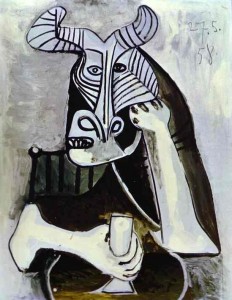
Pablo Picasso, "The King of the Minotaurs" (1958). Oil on canvas.
The other night I was at a dinner where someone suggested that, all things being equal, what ultimately makes the difference in a body of work is the character of the artist. This might fall on most ears as a wildly dicey proposition, but in the context of the conversation it seemed plausible. An artist who is capable of making hard choices and facing unpleasant truths, especially personal ones, will develop a more substantial and exacting practice than someone who possesses a similar range of intellectual and aesthetic gifts but is too narcissistic or insecure for ruthless self-criticism.
Still, the prickly issue of an artist’s character got me thinking about the tendency to regard creative personalities, especially those at an historical remove, as glamorous and forward-thinking, if not downright heroic. This doesn’t hold up under scrutiny, of course. But it does reflect a need for consensus among artists and aficionados—whose values are assaulted daily by the dominant bottom-line culture—that they are on the right side of history.
Never mind that Cezanne, the father of modern art, broke with his childhood friend, Emile Zola, over the Dreyfus case, which was the litmus test for progressive thinkers at the end of the 19th century. The paradoxes and complexities of history include the Fascist affiliations of the Futurists and Ezra Pound, as well as the reputed, though unverified, reason for Fritz Lang’s emigration to the United States—not to escape Nazi persecution, as was the case with Arnold Schoenberg, Bertolt Brecht, and countless others, but to elude a prestigious job offer from Joseph Goebbels.
Perhaps it is a throwback to the ancient belief that the inscrutable pronouncements of the oracles were the disguised prophecies of the gods, but when an artwork thrusts us into new experiential territory, we seem atavistically susceptible to the notion that it contains the spark of the divine. And what is the divine if not all-knowing, all-loving, and all-powerful? How could the vessels through which such revelations pass, to paraphrase Stravinsky’s famous remark on The Rite of Spring, be liable to the mundane corruptions of the flesh?
Easily. Instead of retreating into misty, neoclassical visions of Apollo speaking through the Oracle of Delphi, maybe we should recast our imaginations to consider the influence of hallucinogenic vapors (as archeologists have recently conjectured) on the prophetic voice. Not to advocate artificial stimulants or to diminish the power of imagination, but to emphasize the bodily origins of prophecy which, like aesthetic innovation, define themselves by stepping outside the slipstream of their own time. Prophets and artists, both in the business of extracting undiscovered or unacknowledged truths, must peel away the strictures of social conventions in order to see the world anew. They are not necessarily good persons, but certainly uninhibited ones, compulsively groping through the intricacies of their own flawed humanity. This is why someone as self-contradictory as Picasso so dominated the art of the last century.
Mythology is replete with tales of those who challenged the supremacy of the gods or the limits of the human condition (Marsyas, Icarus, Prometheus) and paid a hideous price for their hubris. That is one metaphor of the artist—reaching for the heavens one moment, crashing and burning the next. Another can be found in Picasso’s innumerable images of the Minotaur, a figure who can navigate the labyrinthine passages between human aspirations and animal instincts, but only because he is himself a grotesque amalgam of man and beast. Picasso gives form to our inner monsters by calling out his own.




Pingback: Dialing Back | Art21 Blog
Pingback: I Like That « Freese